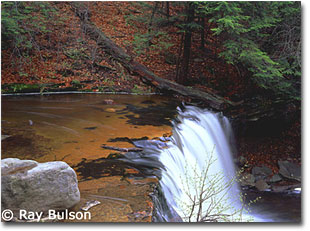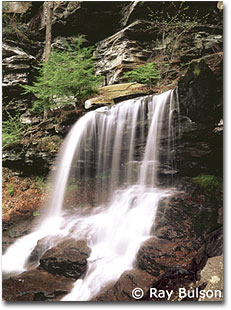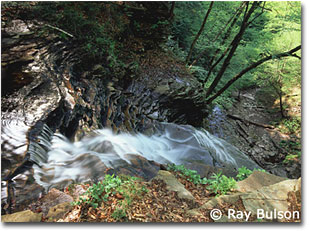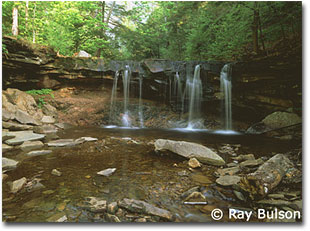|
|
 Photo Itinerary... Ricketts Glen State Park - Waterfall Heaven
All rights reserved.
Ricketts Glen State Park is located about twenty-five miles west of Wilkes Barre in the Pocono Mountains of northeastern Pennsylvania. Overall, it is about a two and one-half hour drive north of Philadelphia. Ricketts Glen is said to be one of the most scenic areas in all of Pennsylvania. While I have seen much of Pennsylvania - certainly not all of it - I can't imagine another place anywhere with a higher concentration of shooting opportunities for waterfalls. The park is comprised of over 13,000 forested acres atop Red Rock Mountain (2449 feet). Within the Glens Natural Area, a Registered National Natural Landmark, resides twenty-two named waterfalls. A five mile loop on the Falls Trail takes the hiker through the Ganoga Glen and Glen Leigh gorges where twenty-one of the falls can be seen. The two branches of Kitchen Creek that flow through these gorges unite at "Waters Meet" where they then flow through Ricketts Glen. Ten named waterfalls are in Ganoga Glen and eight in Glen Leigh. Four more named waterfalls are downstream of Waters Meet.
On sunny, clear days, contrast around the falls is high. Because of the depth of the gorge, what light is available will often be directional and spotlight in quality. The reflective quality of the falling water can fool a camera meter - even one using matrix metering - into underexposing the surrounding foliage. You will often have to add 0.3 to 1.0 EV more exposure to a matrix meter reading. Better still, use a hand held meter or your in-camera spot meter to measure the EV range from the darkest to the lightest parts of your picture. If you are using slide film remember that the exposure latitude is a narrow three stops. Expose for the surroundings, preferably metering some part of the scene that is approximately 18% in reflective quality. Don't worry about overexposing the flowing water. Shutter speeds will likely be ˝ second or more when using a slow speed film with a small aperture to achieve a high depth of field. This will mean that the water will record as a silky smooth continuum. In that case, there will be little detail in the water. Also, I find the brighter water looks more natural. Be aware of reciprocity at long exposures shifting colors and compensate accordingly with the shutter speed. Personally, this has not been a problem for me with Velvia, even at 10-20 seconds exposure. Print film, with its wider exposure latitude of five stops or more, offers more opportunities to capture the waterfalls and surrounding foliage with a nice blue sky background for contrast.
The Falls Trail is rated as a very difficult trail, mainly due to the steep, rocky terrain. Stone and terrace steps provide some relief in difficult sections, although they are not always spaced for the average person. I don't mind admitting to occasionally sliding down on my rear to protect camera equipment and myself. Trail conditions are frequently wet and slippery from water runoff and ground seepage. In many sections, the trail narrows to one-person ledges that bring you close to the proximity of the falls or around certain rock outcroppings. Despite the warnings at the trailhead, there have been several serious injuries from falling accidents mainly due to people attempting the trail without hiking boots. Needless to say, good physical conditioning, sturdy hiking boots, and some common sense can make this an enjoyable and memorable experience.
In geologic time, the life span of a human is infinitesimally short, and so we come to expect the appearance of the falls should not change appreciably during our lifetime. Yet in just the few short years that I have been coming to Ricketts Glen, the falls have recreated themselves. How many times I do not know. This year as I walked past Oneida Falls, I wondered what happened to the golden hues of the stream bed below the flowing water. I could not believe that this was the same falls that I had shot three years earlier. It did not look the same. As indelibly as I thought I had captured this moment in time on film, it has more indelibly etched my mind and spirit with wonder; the inner voice that goes forth comes back a thousand-fold. As I search and find wonder, I am awed, but at the same time humbled by the response of Nature. Think not that you can over analyze, and hence understand completely, her appeal. The more you explore the pieces, the more enigmas of beauty you will find. They will not "go away" and the quest is never ending. Here I go again thinking too much. I can't help it. It's the magic of this enchanting place that inevitably expands my mind and spirit as it expands my photography. For more information on Ricketts Glen State Park visit the park's website at http://parec.com/state_parks/rickstpk.htm. Editor's Note - View more of Ray Bulson's work at www.wilderness-visions.com. About the images… Oneida Falls, Ganoga Glen Gorge Wyandot Falls, Glen Leigh Gorge Ganoga Falls, Ganoga Glen Gorge Oneida Falls, Ganoga Glen Gorge Comments on this article? Send them to the editor. |
|
|
 What is it about waterfalls that we find so appealing? Is it the raw, inexhaustible power of a Niagara? Or the delicate sheer form of Yosemite's Bridalveil in the late summer? Are we lulled into tranquility by their soothing melodies? Or, does their continual renewal remind us of the passage of time and the circle of life? Perhaps words are inadequate to express their true meaning, and so as photographers we place our faith and inner voice in the brief moment of time captured on film to speak for us. In "The Bridges of Madison County" Robert James Waller said, "Analysis destroys wholes. Some things, magic things, are meant to stay whole. If you look at their pieces, they go away." For me, waterfalls are magic, and I know of no better place to capture the magic than Ricketts Glen State Park in Pennsylvania.
What is it about waterfalls that we find so appealing? Is it the raw, inexhaustible power of a Niagara? Or the delicate sheer form of Yosemite's Bridalveil in the late summer? Are we lulled into tranquility by their soothing melodies? Or, does their continual renewal remind us of the passage of time and the circle of life? Perhaps words are inadequate to express their true meaning, and so as photographers we place our faith and inner voice in the brief moment of time captured on film to speak for us. In "The Bridges of Madison County" Robert James Waller said, "Analysis destroys wholes. Some things, magic things, are meant to stay whole. If you look at their pieces, they go away." For me, waterfalls are magic, and I know of no better place to capture the magic than Ricketts Glen State Park in Pennsylvania. Of the two gorges, Ganoga Glen Gorge is my favorite as I feel it is the more scenic. When you enter either gorge, it is like entering a tunnel into another time. Lush old-growth forest of giant pines, hemlocks and oaks, some 500-900 years old and soaring to 100 feet surround you. The microclimate created by the gorge is moist and the air is cool. If you ran into a dinosaur around the next bend in the trail it would not seem out of place. It is not long before you reach the first waterfall. Falls range in height from the 11 feet of Cayuga Falls to the 94 feet of Ganoga Falls. Over half of the falls are 20-47 feet in height. Technically, some are cascades, because the water does not free fall, but they are equally as beautiful. The natural arrangement of trees and bushes around some waterfalls creates the feeling of being in an amphitheater. The waterfall is center stage and the challenge is to capture it on film in difficult lighting.
Of the two gorges, Ganoga Glen Gorge is my favorite as I feel it is the more scenic. When you enter either gorge, it is like entering a tunnel into another time. Lush old-growth forest of giant pines, hemlocks and oaks, some 500-900 years old and soaring to 100 feet surround you. The microclimate created by the gorge is moist and the air is cool. If you ran into a dinosaur around the next bend in the trail it would not seem out of place. It is not long before you reach the first waterfall. Falls range in height from the 11 feet of Cayuga Falls to the 94 feet of Ganoga Falls. Over half of the falls are 20-47 feet in height. Technically, some are cascades, because the water does not free fall, but they are equally as beautiful. The natural arrangement of trees and bushes around some waterfalls creates the feeling of being in an amphitheater. The waterfall is center stage and the challenge is to capture it on film in difficult lighting. I prefer to shoot in the early morning light or overcast conditions since the light is more diffuse and less directional. For the last three years I have visited the park primarily in early spring, when the trees are just blooming. With a less dense tree canopy, the light on the falls is more open and even. In a typical year, I have found that spring in Ricketts Glen is about two weeks behind that in Delaware where I live. This is because the park is further north and over 2000 feet higher in elevation. So when the trees are just in full bloom in Delaware - usually in mid-May - they are just starting to bloom in Ricketts Glen. Also, early spring brings the highest water flow from the melting snows, showers and runoff. Nevertheless, my timing was off this year. Not only were the trees in full bloom, but the water flow over the falls was the lowest I have experienced. However, it made for an interesting and different rendition of Ganoga Falls with the water gently stepping down Nature's rock stairs. Finally, whether you shoot under overcast conditions, or under the canopy of the trees, the light will impart a cool, bluish tone to the film, so use a warming filter, like an 81A, to bring the color temperature back to normal.
I prefer to shoot in the early morning light or overcast conditions since the light is more diffuse and less directional. For the last three years I have visited the park primarily in early spring, when the trees are just blooming. With a less dense tree canopy, the light on the falls is more open and even. In a typical year, I have found that spring in Ricketts Glen is about two weeks behind that in Delaware where I live. This is because the park is further north and over 2000 feet higher in elevation. So when the trees are just in full bloom in Delaware - usually in mid-May - they are just starting to bloom in Ricketts Glen. Also, early spring brings the highest water flow from the melting snows, showers and runoff. Nevertheless, my timing was off this year. Not only were the trees in full bloom, but the water flow over the falls was the lowest I have experienced. However, it made for an interesting and different rendition of Ganoga Falls with the water gently stepping down Nature's rock stairs. Finally, whether you shoot under overcast conditions, or under the canopy of the trees, the light will impart a cool, bluish tone to the film, so use a warming filter, like an 81A, to bring the color temperature back to normal. Ricketts Glen State Park offers endless opportunities for the outdoor photographer. It is a place guaranteed to expand your photographic skills. Already I have ideas for trips to come. What will the waterfalls look like in mid-winter? What if I use radio slaved flashes to light up the shadows? How will the perspective of a 17 mm ultra-wide angle lens change the way the falls appear? What if I shot behind the falling water from within the undercut rock, say of Oneida Falls during low water flow?
Ricketts Glen State Park offers endless opportunities for the outdoor photographer. It is a place guaranteed to expand your photographic skills. Already I have ideas for trips to come. What will the waterfalls look like in mid-winter? What if I use radio slaved flashes to light up the shadows? How will the perspective of a 17 mm ultra-wide angle lens change the way the falls appear? What if I shot behind the falling water from within the undercut rock, say of Oneida Falls during low water flow?